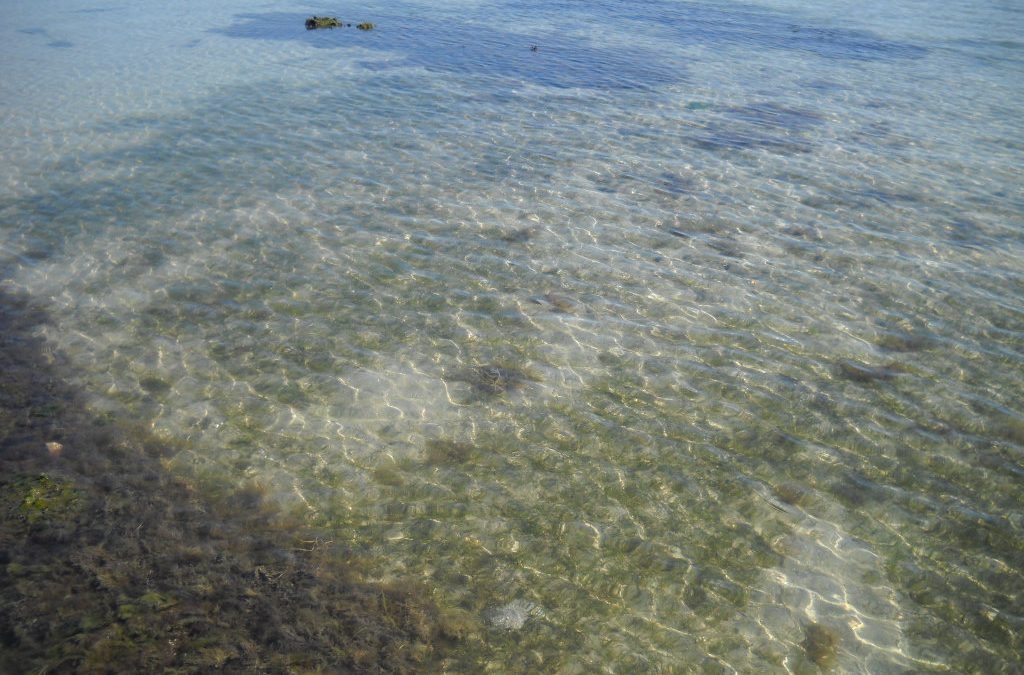
by Rick O'Connor | Apr 14, 2018
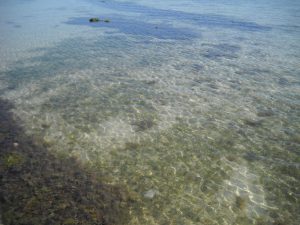
Shoal grass. One of the common seagrasses in Florida.
Photo: Leroy Creswell
For many, it really does not matter. But is there a difference? Yes… there is. Seagrass is what typically washes ashore on the Sound side – seaweed is what we typically see on the Gulf.
So what is the difference?
Seagrasses are actually grasses. They are true plants in the sense they have roots, stems, and leaves. They also produce flowers, but they are so small it is very hard to see them. Pollen and seed dispersal is via the currents. What the observer sees when snorkeling in seagrass meadows are the leaves – in this case called blades. The stems run horizontal beneath the sand, as many grasses in our lawns do. These are called rhizomes, and the roots extend from them. Turtle grass and Shoal grass are the two most common types we have here.
Seaweeds on the other hand, are not true plants because they lack roots, stems, and leaves. They are often called algae and must be submerged in water in order to absorb it. They are either float and drift in the currents, or can attach to hard objects on the seafloor using a structure called a holdfast. June grass and Sargassum are two common types that drift ashore.
So why don’t seagrasses grow in the Gulf?
Like all plants, seagrasses need sunlight. At least 25% of the sunlight reaching the surface must reach the bottom for them to photosynthesize. Near the shore, there is enough sunlight for seagrass, but they cannot tolerate the larger waves that our nearshore Gulf produces – thus they are restricted to the quieter waters of the Sound. We do have seagrasses growing in Big Lagoon, Old River, parts of Pensacola Bay, and even in some of the local bayous. This ecosystem is important to the overall health of our bay. It is known that 80-90% of the commercially and recreationally important finfish and shellfish require seagrasses, or salt marshes, for at least part of their life cycle – so they are important economically as well.
Seaweeds also need sunlight. In rocky areas, you can find them attached in sunlit waters. Much of our area is sand, so we do not see as many forms of seaweed as they do in the Keys or in California. However, we do have floating forms.
March is “Seagrass Awareness Month”. Many people provide opportunities to educate locals about our seagrasses and the issues they are facing. Excessive run-off from parking lots, ramps, homes, etc. – increase the turbidity and decrease the salinity of the water – both of which are detrimental to seagrass health. This run-off also contains pollutants that are problematic – particularly nutrients from fertilizers. The fertilizers trigger algal blooms which block sunlight and, in some cases, smoother the surface of the grass blades. Then there is prop scarring. The shallow waters where they live are also popular spots for boaters to visit. The propeller scarring leaves open tracts throughout the seagrass meadows and, unlike some grasses in our yards, can take years – even decades – to recover. There has been significant loss of seagrass all across the Gulf region, including Pensacola Bay. The loss of seagrass have also affected species such as bay scallop and horseshoe crabs. There are signs of recovery and we need to continue reducing our impact to keep this trend going. Florida Friendly Landscaping, Clean Boater practices, and Living Shorelines are some methods that can help. Contact your local County Extension Office to learn more about these programs.
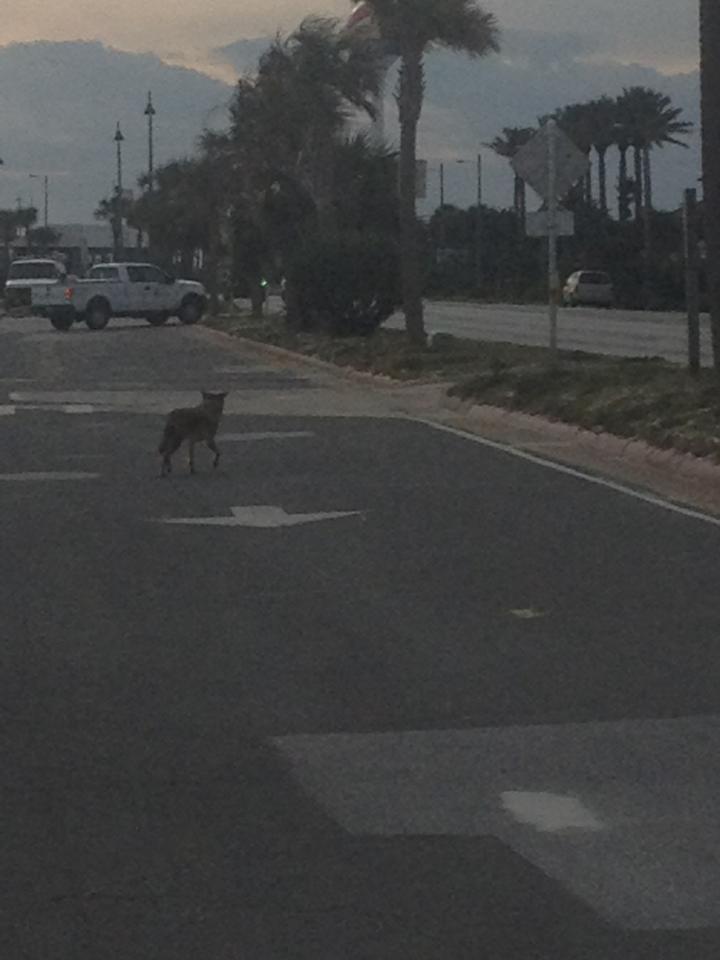
by Rick O'Connor | Apr 14, 2018
In my job, I get many calls about snakes. Most people want to know how to tell a venomous from a nonvenomous one and how to keep them out of the yard. I was recently reading a new book out by Dr. Sean Graham entitled American Snakes and in the chapter on snake defenses, he provided a long litany of local creatures who consumed snakes – some surprised me. Check this out…
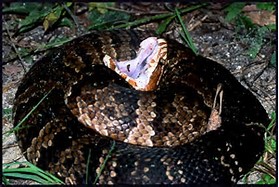
The “cottonmouth” gape of this venomous snakes is a warning. Notice the banded coloration of this individual.
Photo: UF IFAS Wildlife
First, most who do only consume smaller species of snakes – but the list is still surprising. Spiders… spiders were on the list. He specifically called out the black widow – who probably could kill a small snake, but indicated there were others. Scorpions, centipedes, fire ants, carpenter ants, giant water bugs, crayfish, and crabs made the list as well. Some of these may consume snakes only after they are dead – but some can kill small ones.
From the vertebrate world he mentions the larger salamanders (such as the hellbender), and other snakes (such as the short-tailed snake and the coral snake). There are several mammals including shrews, moles, and even the rodents themselves are consumers of snakes! He describes how hoofed mammals (such deer, goat, and horses) do not consume snakes, but can completely destroy one by raising and stopping on them – leaving only small segments remaining. They have found the remains of snakes in the stomachs of all predatory mammals but the snake’s greatest threat are birds… by a long shot. Species from passerines to raptors have been known to kill and consume snakes.
What about venomous snakes – who consumes rattlesnakes and cottonmouths?
There are surprises here as well…
Bullfrogs… bullfrogs basically consume what they can get into their mouths but this includes snakes – and venomous ones as well (though they would be small ones). From the fish world, both the gar and largemouth bass are known to consume venomous snakes.
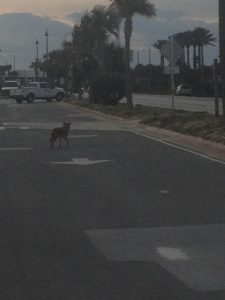
A coyote moving on Pensacola Beach near dawn.
Photo provided by Shelley Johnson.
Opossums are known to consume at least 12 species of snakes, including venomous ones. They also consume ticks, fire ants, and have a very low occurrence of rabies – a cool animal to have around.
Other mammal consumers of venomous snakes include raccoons, otters, fox, bobcats, coyotes, and black bears. It is understood they must take smaller members of the venomous snake population – but a snake control is snake control.
Most wading birds in our marshes consume snakes, including venomous ones, but it is the red-tailed hawk and the great horned owl that are the masters. Red-tailed hawks are known to consume at least 35 species of snakes, including venomous ones, and – unlike other snake predators – are a larger part of their diet, they seek them out. Great Horned Owls consume at least 13 species, and venomous ones are on the menu.
From the reptile world we begin with the alligator, who has little problem consuming large specimens of both the rattlesnake and the cottonmouth. However, many are snakes… yes, snakes eat snakes and some consume venomous ones. Coral snakes, coachwhips, and cottonmouths have been known to consume other snakes. However, it is the Eastern Indigo and the Kingsnakes who actively seek out venomous species. It is known that kingsnakes have a protein in their blood that makes them immune to the viper’s venoms – and it appears the vipers know this and avoid them. It is not known whether the indigo is immune, but it is known they will seek out venomous snakes and consume. Both of these snakes can take relatively large venomous species.
Of these two, it is the Kingsnake who is the “king” – consuming at least 40 species of snakes. However, both the kingsnakes and the indigo are on the declined. The eastern indigo is currently federally listed as endangered – there has not been a verified record of one in the Florida panhandle since 1997. However, there are anecdotal reports and we encourage anyone who has seen one to send us a photograph. There is an active indigo restoration program going on in Alabama and in the Apalachicola River area. These are the largest native snakes in the U.S. (about 8 feet) and, along with the six-foot kingsnakes, are frequently killed. There is evidence that as the eastern kingsnake populations decline copperhead populations increase, and Vis versa. Some areas near Atlanta are currently experiencing a copperhead “boom”. Clearly, we should reconsider killing both the indigo and kingsnakes. We also understand that habitat loss is another cause of their decline, particularly in the case of the indigo.
When looking at this list of snake consumers we see species that cause other problems – alligators, raccoons, coyotes, and bears have all have had their negative issues. But many we just do not like, such as the opossum, really cause us no harm and control snake populations. Everything has its place in the local environment and not one species seeks out humans for the purpose of harming us – this would include snakes. The negative encounters are for other reasons. But for those who have a deep fear, or are currently experiencing high snake numbers, seeing one of the animals on this in the neighborhood could be a relief.
References
Graham, S. 2018. American Snakes. John Hopkins University Press. Baltimore MD. Pp 293.
O’Connor, M. 2018. Personal communication.
by Laura Tiu | Apr 14, 2018
Spring has sprung and it is time to get outside and explore this great Florida Panhandle area. In neighboring Santa Rosa County, a terrific destination for a variety of outdoor activities is Blackwater River State Park. Visitors can canoe, kayak, tube, fish and swim the river. Hikers can enjoy trails through nearly 600 acres of undisturbed natural communities. Bring a picnic and hang out at one of several pavilions or white sand beaches that dot the river (restroom facilities available). Near the pavilions, stop and see one of the largest and oldest Atlantic white cedars, recognized as a Florida Champion tree in 1982. The park also offers 30 campsites for tents and RVs. Park entry is $4.00 per car, payable at the ranger station or via the honor system (bring exact change, please).
The Blackwater River is considered one of the purest and pristine sand-bottom rivers in the world. The water is tea-colored from the tannins and organic matter that color the water as it weaves through the predominantly pine forest. The river is shallow with a beautiful white sandy bottom, a nice feature for those tubing or paddling the trail. The river flows for over 50 miles and is designated as a Florida canoe trail. Multiple small sand beach areas line the river and provide plenty of space to hang out, picnic, or throw a Frisbee. Blackwater eventually flows into Pensacola Bay and the Gulf of Mexico bringing high quality freshwater into this important estuary.
A favorite trail in the Park is the Chain of Lakes Nature Trail. Parking for this 1.75 mile loop trail is at South Bridge on Deaton Bridge Road. The trail head is well marked and has a boardwalk that leads into the floodplain forest. The trail winds through a chain of shallow oxbow lakes and swamp that dot the former route of the river. If you are lucky and it is a clear, blue-sky day, you may see a beautiful rainbow effect as the sun hits the water. We call this the pastel swamp rainbow effect. This is a result of the natural oils from the cypress cones settling on the surface of the water and associated trapped pollen.
The trail then turns to sneak through the sandhill community in the park with giant longleaf pines, wiregrass and turkey oak. Evidence of prescribed burning shows management efforts to maintain the forest. Cinnamon ferns, bamboo and other natives appear in pockets along the trail. The trail in this section is blanketed with a mosaic of exposed root systems, so be careful as you step. Finally, pack some bug spray and a water bottle for this fun hike.
For more information, visit the park page: https://www.floridastateparks.org/park/Blackwater-River
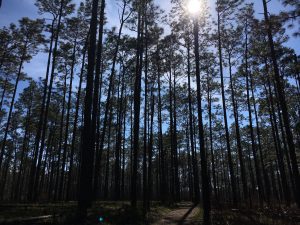
Sandhill pine forest at Blackwater River State Park
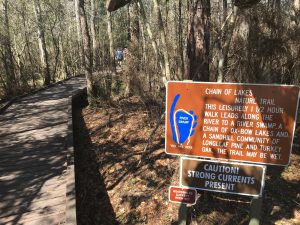
2737 – Chain of Lakes trailhead at Blackwater River State Park
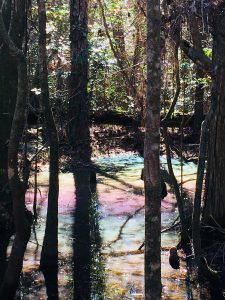
“Rainbow Swamp” on the Chain of Lakes trail at Blackwater River State Park
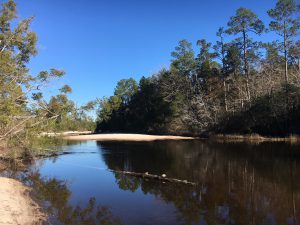
Beautiful sandy beaches along the Blackwater River in the State Park.
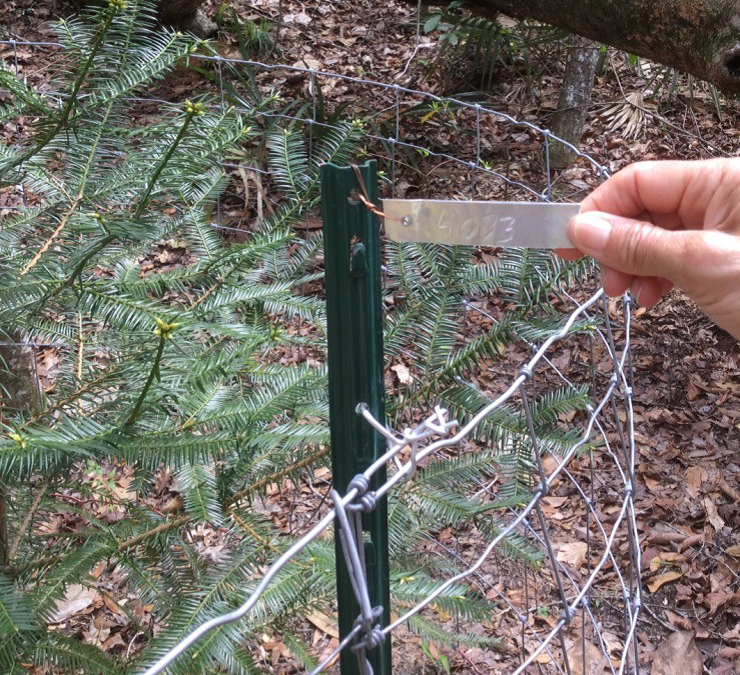
by Sheila Dunning | Apr 14, 2018
Having just completed the Okaloosa/Walton Uplands Master Naturalist course, I would like to share information from the project that was presented by Ann Foley.
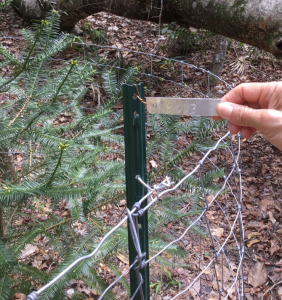
The Florida Torreya. Photo provided by Shelia Dunning
The Florida Torreya is the most endangered tree in North America, and perhaps the world! Less than 1% of the historical population survives. Unless something is done soon, it may disappear entirely! You can see them on public lands in Florida at Apalachicola Bluffs and Ravines Preserve and beautiful Torreya State Park.
The Florida Torreya (Torreya taxifolia) is one of the oldest known tree species on earth; 160 million years old. It was originally an Appalachian Mountains ranged tree. As a result of our last “Ice Age” melt, retreating Icebergs pushed ground from the Northern Hemisphere, bringing the Florida Torreya and many other northern plant species with them.
The Florida Torreya was “left behind” in its current native pocket refuge, a short 40 mile stretch along the banks of the Apalachicola River. There were estimates of 600,000 to 1,000,000 of these trees in the 1800’s. Torreya State Park, named for this special tree, is currently home to about 600 of them. Barely thriving, this tree prefers a shady habitat with dark, moist, sandy loam of limestone origin which the park has to offer.
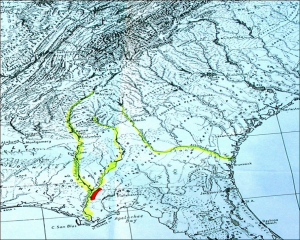
Hardy Bryan Croom, Botanist, discovered the tree in 1833, along the bluffs and ravines of Jackson, Liberty and Gadsen Counties, Florida and Decatur County in Georgia. He named it Florida Torreya (TOR-ee-uh), in honor of Dr. John Torrey, a renowned 18th century scientist.
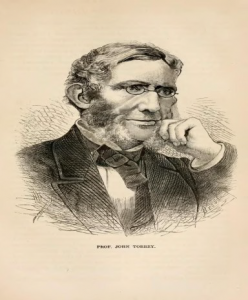
Torreya trees are evergreen conifers, conically shaped, have whorled branches and stiff, sharp pointed, dark green needle-like leaves. Scientists noted the Torreya’s decline as far back as the 1950’s! Mature tree heights were once noted at 60 feet, but today’s trees are immature specimens of 3-6 feet, thought to be ‘root/stump sprouts.’
Known locally as “Stinking Cedar,” due to its strong smell when the leaves and cones are crushed, it was used for fence posts, cabinets, roof shingles, Christmas trees and riverboat fuel. Over-harvesting in the past and natural processes are taking a tremendous toll. Fungi are attacking weakened trees, causing the critically endangered species to die-off. Other declining factors include: drought, habitat loss, deer and loss of reproductive capability.
With federal and state protection, the Florida Torreya was listed as an endangered species in 1983. There is great concern for this ancient tree in scientific community and with citizen organizations. Efforts are underway to help bring this tree back from the edge of extinction!
Efforts include CRISPR gene editing technology research being done by the University of Florida Dept. of Forest Resources and Conservation- making the tree more resistant to disease. Torreya Guardians “rewilding and “assisted migration”. Reintroducing the tree to it’s former native range in the north near the Biltmore Estate in Asheville, NC, which has maintained a grove of Torreya trees and offspring since 1939 and supplying seeds for propagation from their healthy forest. Long before saving the earth became a global concern, Dr. Seuss (Theodor Seuss Geisel), spoke through his character the Lorax warning against urban progress and the danger it posed to the earth’s natural beauty. All of these groups, and many others, hope their efforts will collectively help bring this tree back from the brink!













